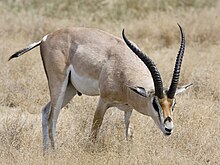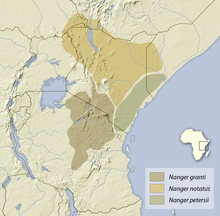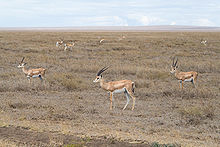Grant's gazelle
| Grant's gazelle | |
|---|---|

| |
| A male at the Ngorongoro Crater , Tanzania
| |
| Scientific classification | |
| Domain: | Eukaryota |
| Kingdom: | Animalia |
| Phylum: | Chordata |
| Class: | Mammalia |
| Order: | Artiodactyla |
| Family: | Bovidae |
| Subfamily: | Antilopinae |
| Tribe: | Antilopini |
| Genus: | Nanger |
| Species: | N. granti
|
| Binomial name | |
| Nanger granti | |

| |
| The distribution of Grant's gazelles | |
| Synonyms | |
|
Gazella granti | |
Grant's gazelle (Nanger granti) is a relatively large species of gazelle antelope, distributed from northern Tanzania to South Sudan and Ethiopia, and from the Kenyan coast to Lake Victoria.[3] Its Swahili name is swala granti.[4] It was named for a 19th-century British explorer, James Grant.[5]
Taxonomy and genetics
Grant's gazelle is genetically related to

Subspecies
Listed alphabetically.[2]
- N. g. granti (Brooke, 1872) – southern Grant's gazelle
- N. g. lacuum (Neumann, 1906) – northern Grant's gazelle
- N. g. robertsi (Thomas, 1903) – Roberts' gazelle
Description
The Grant's gazelle stands 75–95 cm (30–37 in) at the shoulder. The females weigh from 35 to 50 kg (77 to 110 lb) and males from 50 to 80 kg (110 to 180 lb).[8][4] Its coat is a beige orange on the back with a white belly. The Grant's gazelle looks similar to a Thomson's gazelle, except it is much larger and has lyre-shaped horns which are stout at the base, clearly ringed, and measuring 45–81 cm (18–32 in) long. A useful field mark is the white on the rump that extends over the top of the tail in Grant's but not Thomson's gazelles. The subspecies are segregated by different morphological characters, such as horn shape and slight differences in coat colour.[3] These differences are not indicative of ecological separation as with some species.[3]
Ecology, distribution and behaviour

Grant's gazelle are found in several countries in East Africa, including Ethiopia, Kenya, South Sudan and Tanzania, where they live in small to midsized herds, separated into females with juveniles and bachelor groups; during the mating season, when males become territorial and protective over a harem of females to breed with, bachelor herds briefly married disperse before tensions die-down again. Confrontations between hormonal males rarely end in violence or death, with the ‘loser’ simply fleeing.
Grant’s gazelle prefer living on short, grassy plains where they can graze, but can also be found browsing and foraging in more sparse, arid scrublands; they avoid areas with excessively high, untrimmed grass with compromised visibility of predators. They also occur in

The most common predators of the Grant's gazelle are the
At rivers, streams and some lakes,
Humans also hunt gazelle, the meat being fairly popular in some areas. In the Serengeti, Grant's gazelle is a potential prey item for the cheetah, but the smaller Thomson's gazelle is preferred; in Nairobi National Park, Grant's gazelle are seemingly preferred by cheetahs over Thomson's gazelle, making them an important resource for the cheetah.[10] Black-backed jackals are major predators of fawns.

The Grant's gazelle is a
The bachelor groups are composed of adolescent males and adult males not currently holding territory. Any potentially new members will perform mock-intimidation displays to enter the group.[13] However, bachelor groups tend to be loose and members can come and go at-will. Grant's gazelle will sometimes join groups of Thomson's gazelle to protect themselves from predators. Predators are less likely to attack the Grant's gazelle when associated with these mixed groups, perhaps because the Thomson's gazelle provides an easier target.[14] The larger, older males with thick horns have the best chance of establishing a territory.[15] Conflicts between adult males are usually solved with intimidation displays. The bucks circle each other and swing their necks from side to side, displaying their neck power.[16] Neck strength is important in an actual fight and the male that cannot keep up yields. Gazelles of nearly equal neck strength are more likely to engage in actual combat. Fighting occurs in young males more often than older ones. Dominant males can simply run off subordinates rather than having to display to them.

Diet
Grant's gazelles are generally mixed feeders that both browse and graze. In one study, their diet consisted of 66% browse and 34% graze.[17] Rainfall seems to be a determinant of their diets.[17] One way the Grant's gazelle withstands dehydration and heat stress is by being very efficient in digesting dry matter. Grant's gazelles consume a smaller amount of food than domesticated animals, but they are better-suited for extreme environments because they derive protein from forage more quickly.[18] The Grant's gazelle's diet may be responsible for the slow growth rates of browsed plants.[19] They get most of their moisture from the plants they eat, so they do not often have to drink water. Thus they can stay on the plains long after the rains end. In dry seasons, gazelles move deep into dense brush and wait for the next rains.[13] They will eat red oat grass and small, tough plants,[20] which are avoided by the other ungulates. This allows the gazelles to survive in the brush during the dry season. Grant's gazelles eat mainly dicotyledons during the dry season and grass in the wet season.[21]
Reproduction
Grant's gazelles sexually mature at 18 months. Territory-holding males mate more than those in bachelor groups.[16] The courting ritual begins with a male following a female, waiting for her to urinate. When she does, the male does the Flehmen response to determine if she is in estrus.[22] If she is, he will continue to follow her. The female will lift her tail, signaling she is ready to mate, and the male will mount her.[16] The gestation period for the gazelle lasts for 198 days.[23] Births in the Serengeti peak in January and February. A female will leave her herd and find a well-hidden place to give birth. Afterwards, the female eats the afterbirth and other fluids to keep the fawn clean and scentless. Females that have recently given birth will stay together for protection.[16] The females nurse their fawns four times a day. Fawns are immobile for the first few days, and the mother stays close by.[24] When the fawn can walk, it leaves with its mother to join a herd.[25] Around this time, fawns will associate with one another in peer groups. A gazelle is weaned at six months, but will continue to associate with its mother until adolescence.[16]
Threats and conservation
The Grant's gazelle is still a common species, despite having been eradicated in certain areas. Major threats have been habitat destruction and poaching. The gazelle's status as an unthreatened species is dependent on protection of the national parks and reserves where it lives, including Serengeti National Park and Ngorongoro Conservation Area in Tanzania, and Lake Turkana National Parks in Kenya. Estimates of the population range from 140,000 to 350,000. While certain areas have stable populations, overall the population trend is going downward.[1]
References
- ^ . Retrieved 19 November 2021.
- ^ OCLC 62265494.
- ^ a b c d e f g Peter Arctander; et al. (1996). "Extreme genetic differences among populations of Gazella granti, Grant's gazelle, in Kenya" (PDF). Heredity. 76 (5). Retrieved 2008-06-19.
- ^ a b Grant's Gazelle, Out of Africa
- ^ Sir Victor Brooke (1872). "On a supposed new Species of Gazelle from Eastern Africa". Proceedings of the Zoological Society: 601–602. Retrieved 2015-05-20.
- ^ "Nanger notatus (O. Thomas, 1897)". ASM Mammal Diversity Database. American Society of Mammalogists.
- ^ "Nanger petersii (Günther, 1884)". ASM Mammal Diversity Database. American Society of Mammalogists.
- ^ "Archived copy" (PDF). Archived from the original (PDF) on 2013-12-30. Retrieved 2012-04-20.
{{cite web}}: CS1 maint: archived copy as title (link) - .
- ^ .
- ^ "Hippo crushes gazelle with one bite".
- .
- ^ PMID 4650796.
- S2CID 53171705.
- .
- ^ a b c d e Estes, R. (1991). The Behavior Guide to African Mammals, Including Hoofed Mammals, Carnivores, Primates. Los Angeles, The University of California Press. pgs. 75-80
- ^ .
- PMID 18644247.
- doi:10.1111/j.1365-2028.1984.tb00701.x. Archived from the originalon 2009-02-05. Retrieved 2008-06-19.
- ^ Cloudsley-Thompson, J. L. (1969). The zoology of tropical Africa. New York, W. W. Norton.
- .
- ^ Hart, Lynette A., and Benjamin L. Hart. "Species-specific patterns of urine investigation and flehmen in Grant's gazelle (Gazella granti), Thomson's gazelle (G. thomsoni), impala (Aepyceros melampus), and eland (Taurotragus oryx)." Journal of Comparative Psychology 101.4 (1987): 299.
- ^ Stuart, C. (1998). Field guide to the larger mammals of Africa. Sanibel Island, FL, Ralph Curtis Books.
- JSTOR 1378022.
- PMID 5890863.

